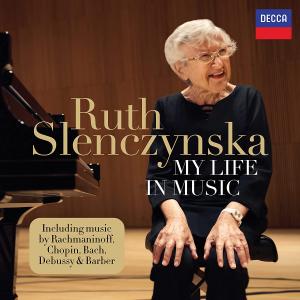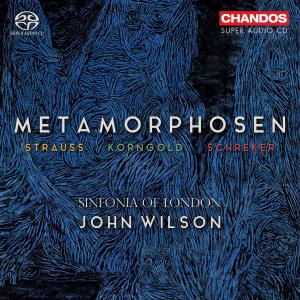CD Review – John Ireland
Sinfonia Of London John Wilson
Chandos CHSA 5293 [67:16]
These days John Wilson and his superlative Sinfonia of London orchestra seem they can play no wrong, with critical plaudits and awards being gathered by each new release. They have all been reviewed on these pages, but I realise that the heavier fare on some albums may not always appeal to those readers who admire John for his earlier work as a conductor of light music. This latest should not be among them.
CD Review – Trevor Duncan – 20th Century Express / Little Suite / Children in the Park
Written by Peter BurtCD Review – Trevor Duncan
20th Century Express / Little Suite / Children in the Park
Slovak Radio Symphony Orchestra / Andrew Penny
Naxos 8.555192 [68:27]
Trevor Duncan – real name Leonard Charles Trebilcock – was a Londoner born in 1924 and lost to us in 2005. He will be best known, especially to oldies like me, for the March from his Little Suite – the signature tune for the 1962-71 TV series of A J Cronin's 'Dr Finlay’s Casebook' – also The Girl from Corsica and Enchanted April, the title tune of another TV programme.
Ol’ Man River
(Words Oscar Hammerstein II, music Jerome Kern)
Analysed by Robert Walton
Why does the song Ol’ Man River sound so ancient? It’s much more than just Hammerstein’s brilliant lyrics, although they obviously help.
Ol’ Man River
(Words Oscar Hammerstein II, music Jerome Kern)
Analysed by Robert Walton
Why does the song Ol’ Man River sound so ancient? It’s much more than just Hammerstein’s brilliant lyrics, although they obviously help. The simple answer is because of the primitive pentatonic scale (black notes of the piano) which occurs in most of the early music cultures, e.g. in China around 2000 BC. It’s sometimes called the Scottish scale because the bagpipes have a similar tuning - C, D, E, G and A. (Like my ringing chimes). It’s the main chorus of Ol’ Man River that is purely pentatonic using the 5 note scale. Hence the prehistoric atmosphere it creates. It couldn’t be a better setting for such a magnificent tune. Note the built-in syncopation on the word “River” and every third note of each bar in the chorus.
So from China, let’s follow a possible musical journey. First to Africa for the rhythm, America for syncopation, developed by Stephen Foster, a touch of jazz and finally to Jerome Kern who couldn’t have chosen a more appropriate format. If you speed up Kern’s melody, it could be one of the first of the extended “fanfares” before 20th Century Fox got in on the act! But there’s also an extra special tenderness in the main tune at bar 5. In the key of C on the word “JUST keeps rollin’” (Dm9, 11) the effect is overwhelming if you freeze “just”. Play, sing, hum, whistle or just listen to this grand tune. It’s a most all-encompassing experience.
The bridge starts “You and me we sweat and strain”. Like all bridges it begins as the perfect contrast, but when it rejoins the main melody it slips back in, just like from a verse. So in fact there are two verses.
But who first sang this comparatively simple 32 bar popular song? Jules Bledsoe introduced it in the 1927 musical “Showboat” and also the first film version in 1929. However the best-known singer of it was Paul Robeson in the second film version of 1936. The popular third film version of “Showboat” was in 1951 featuring William Warfield. In the film “Till the Clouds Roll By”, Frank Sinatra gave the song an entirely new feeling and freedom, getting away from the predictable basso profondo performances.
My favourite version of Ol’ Man River has got to be the most versatile artist of them all, Gordon MacRae, a legitimate baritone/crooner who sings a very gimmick-less arrangement with the Carmen Dragon Orchestra. (NZ Maori baritone Inia Te Wiata made a fine job of it too). And only recently I came across an outstanding traditional version of the song, sung, but “not crooned” by Dick Haymes. Big bands considered it too sluggish, hence their tendency to play it presto like Ted Heath, when it’s asking to be a medium swing.
Ol’ Man River is unquestionably one of the most moving songs ever written - a colossus in its category! A natural waterway even today carries the vital ingredients of life itself - work, play, family, culture, faith and love. The Mississippi River brilliantly describes the backdrop of the long-suffering African-Americans. Bringing the River Jordan into the mix was a clever move. In answer to Tennyson’s “The Brook” (“Men may come, men may go but I go on forever”), Hammerstein came up with “he just keeps rollin’ along”. Quoting from St. Augustine’s Confessions being “tired of life and afraid of dying” is a clear sign that life was a struggle. In spite of all this, it’s a universal message of hope and optimism.
 CD Review – Musa Italiana
CD Review – Musa Italiana
Riccardo Chailly
Filarmonica Della Scala
Decca 485 2944 [64:00]
Regular readers will be aware of my enthusiasm for the top Italian conductor and his first-rate pit band, as four of their discs have already been reviewed here. The latest recording, from 2021 – socially distanced with a new floor created over the seats of the Teatro alla Scala's Golden Auditorium stalls to accommodate the opera house orchestra – features Felix Mendelssohn's (1809-47) deservedly popular 'Italian' Symphony (No.4 in A).
CD Review – Musa Italiana
Riccardo Chailly
Filarmonica Della Scala
Decca 485 2944 [64:00]
Regular readers will be aware of my enthusiasm for the top Italian conductor and his first-rate pit band, as four of their discs have already been reviewed here. The latest recording, from 2021 – socially distanced with a new floor created over the seats of the Teatro alla Scala's Golden Auditorium stalls to accommodate the opera house orchestra – features Felix Mendelssohn's (1809-47) deservedly popular 'Italian' Symphony (No.4 in A).
CD Review – Strauss/Korngold/Schreker Orchestral Works Sinfonia of London | John Wilson
Written by Peter BurtLuna Park
(Eric Siday)
Analysed by Robert Walton
When I first visited Sydney, Australia, the most memorable thing I saw was Luna Park across the harbour behind the famous bridge. In fact it was the first amusement park I’d ever seen. You couldn’t miss its flashing lights and vertically predominant position like Paris’s Eiffel Tower filling the sky and giving the city its character, years before the opera house. Composer Eric Siday had moved to New York in 1939 so it would have been the famous one at Coney Island which inspired his composition.
Luna Park
(Eric Siday)
Analysed by Robert Walton
When I first visited Sydney, Australia, the most memorable thing I saw was Luna Park across the harbour behind the famous bridge. In fact it was the first amusement park I’d ever seen. You couldn’t miss its flashing lights and vertically predominant position like Paris’s Eiffel Tower filling the sky and giving the city its character, years before the opera house. Composer Eric Siday had moved to New York in 1939 so it would have been the famous one at Coney Island which inspired his composition.
Siday was a violinist and composer who during the 1920s and 30s occasionally doubled on alto saxophone in British dance bands including that of Ambrose and Ray Noble. Little did musicians and music lovers anticipate the coming of Chappell’s Queen’s Hall Light Orchestra in the 1940s. Once it became established the name itself conjured up the finest combination of its kind in the world with players borrowed from the capital’s symphony orchestras. The high standard of tunes, arrangements and names like Robert Farnon, Sidney Torch, Wally Stott (who became Angela Morley), Clive Richardson and Charles Williams told you in no uncertain terms that Light music had reached its Golden Era. No light orchestra has ever come anywhere near its high standard. It must surely have been the pinnacle of such excellence. We would never hear its like again.
Announcing this “down under” pleasure ground, swirling strings quickly show what they’re capable of, rising up and heading for the heights, only to dive down slightly after reaching the top. After a deliberate pause, the busy first chorus gives the arco strings a real chance to display their wares and portray the activities in such a park - the Big Dipper, dodgems, the Ghost Train, and the Big Wheel. This is pure Queen’s Hall Light Orchestra which clearly marks its time and place. And then escaping the repetitive nature of the notes, the strings are given a little freedom with a chorus of longer notes, plenty of syncopation and less tension. But busy is still the operative word!
After another obvious pause we arrive at the official bridge and a tune with some nice decorations, several mini climaxes followed by some fun orchestration and a sudden pizzicato ending.
We immediately return to the opening and the strings are again hard at work with the lively atmosphere that highlights Luna Park. A woodwind flourish briefly cuts in, but we’re soon back to the busyness with a really neat ending.
 CD Review – Ruth Slenczynska
CD Review – Ruth Slenczynska
My Life In Music
Decca 4852255 [67:41]
This is a remarkable release made in 2021 by a pianist – who has been playing since she was aged four – in her 97th year. Born in Sacramento, California, to Polish immigrants, she performed on television at age five, and at six made her European concert debut in Berlin.


